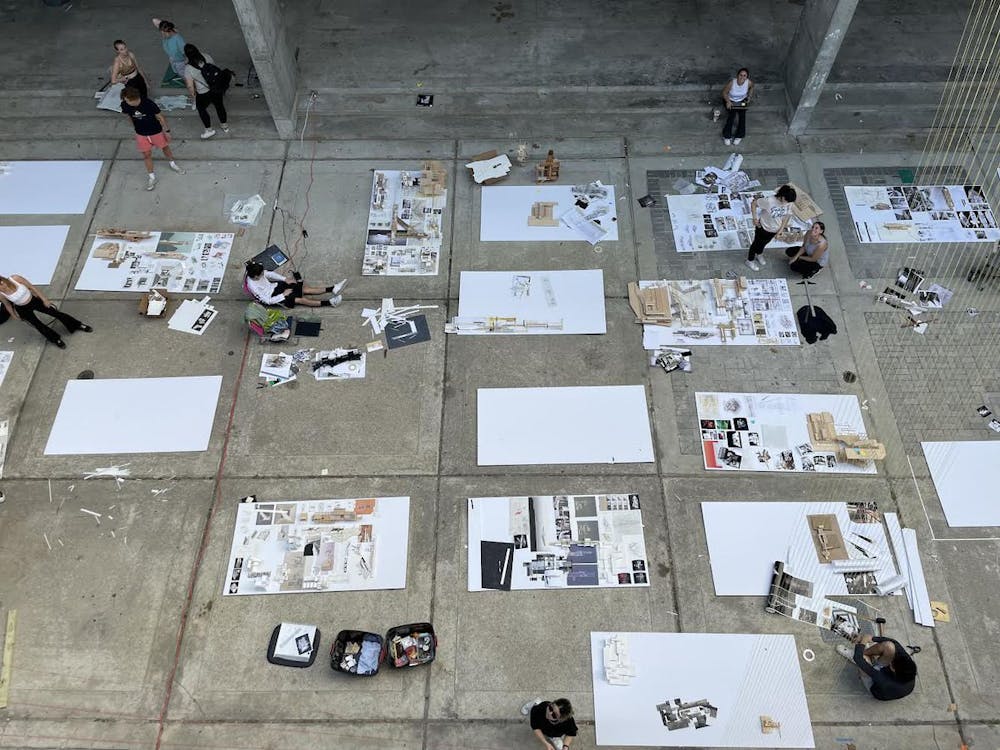Hidden under the School of Architecture's atrium, John Eric Phipps sat with his model of one building in a global system of vaults that would store all human knowledge in the case of an apocalypse.
The secret scene of organized chaos, accented with lonely Exacto knives and abandoned t-squares scattered across the atrium’s cement floor, may be unfamiliar to many UF students. But every Spring, second-year architecture majors face PIN UP, a daunting task that determines if they continue in UF’s architecture program.
Phipps, a 20-year-old architecture sophomore, was joined by 106 students with boards showcasing their photos, sketches and models all laid out in unison underneath the atrium. From above, the atrium looked like a mosaic of white rectangular tiles.
This year, 15 faculty members will pick between 90 to 96 students to progress in the program next year.
With cut fingers bandaged with tape and a napkin, Phipps pinned up his best work on a white 48-by-90 inch board.
Architecture’s creative nature grants him opportunities to create vivid narratives through the buildings he designs.
“I can see myself doing so many things with this degree,” Phipps said. “There's a whole sector of architecture that's not physical architecture, like in video games or in movies.”
Once students were satisfied with their boards, they placed them in the School of Architecture’s gallery and along the hallways that meander through the building. The gallery was open on April 6 and 7.
Noah Kartagener, a 20-year-old UF architecture sophomore, spent a week composing his board. He set aside a day to sift through the box of old works he’d archived under his bed.
His board spotlights his favorite model: a World War I memorial built at a battle site in the French countryside. Kartagener plans to pursue a master’s degree in architecture.
Kartagener often spends about 40 hours a week on his craft, which can lead to the occasional burnout.
“It’s a full-time job,” he said.
Adjusting to in-person classes and events after isolation during the pandemic has challenged architecture sophomores who were not able to see older students’ boards, UF’s School of Architecture undergraduate coordinator Mark McGlothlin said.
“This group didn't have that kind of institutional legacy to build on, which I'm sure they would say has some penalties,” McGlothlin said.
The pandemic-induced intermission has had some benefits, though.
Not being able to reference boards from previous years meant students presented more candid representations of their work without outside influence, he said.
The basic PIN UP process hasn’t changed in several years, architecture professor Lisa Ryzhikova said. She graduated from the UF School of Architecture in 2016 and has taught at the university for one year.
When she was a student, there was not as much digital work, she said. The boards back then were composed mostly of pencil sketches. The program’s shift online in 2020 changed that.
Since the return from the pandemic, Ryzhikova said she noticed more mental health awareness on campus. Although students are still adjusting to in-person classes and the anxiety that might come along with it, she said they are also more comfortable with their professors.
Ryzhikova was only able to build these student-professor relationships in graduate school.
For professor McGlothlin, being able to see students face-to-face has been gratifying. Seeing students help one another despite the competitive nature of the event has been the most rewarding part of PIN UP, he said.
Contact Fernando at ffigueroa@alligator.org. Follow him on Twitter @fernfigue.
Fern is a junior journalism and sustainability studies major. He previously reported for the University and Metro desks. Now, he covers the environmental beat on the Enterprise desk. When he's not reporting, you can find him dancing to house music at Barcade or taking photos on his Olympus.






